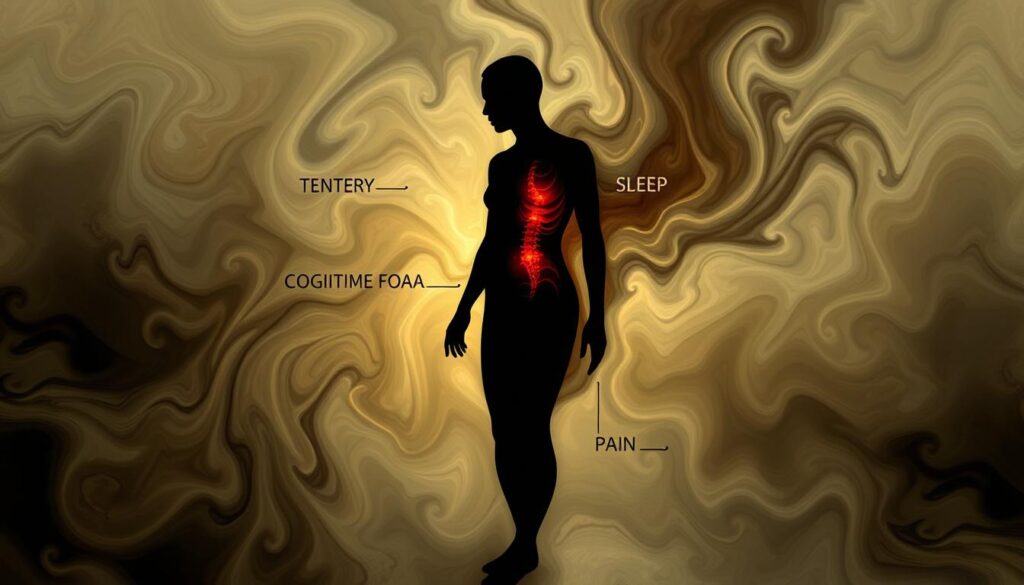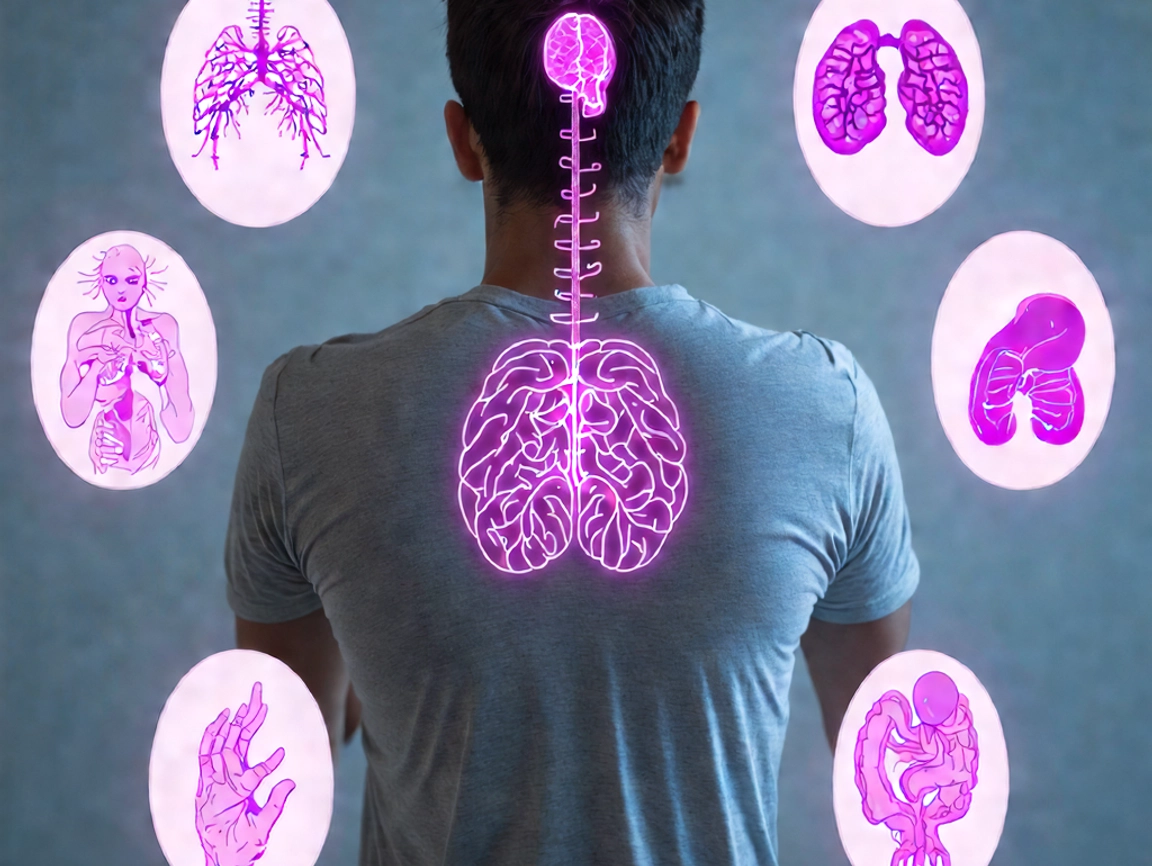Do you often feel pain, tiredness, and trouble sleeping? These can make it hard to do everyday things. Understanding fibromyalgia and its symptoms is key. People with fibromyalgia may feel pain all over, get very tired, and have trouble thinking clearly.

It’s important to know the signs of fibromyalgia to get the right help. Fibromyalgia can look like other health issues, so seeing a doctor is crucial. Learning about fibromyalgia can help you manage your symptoms and live better. We’ll look into what fibromyalgia is, its symptoms, and how to treat it, to help you understand it better.
Understanding Fibromyalgia: A Complex Chronic Condition
Fibromyalgia affects millions in the U.S., with about 5 million adults dealing with it. It mainly impacts the central nervous system, causing widespread pain and fatigue. Knowing the signs and how it differs from other chronic pain is key for diagnosis.
Studies link fibromyalgia to hypothyroidism and autoimmune diseases like rheumatoid arthritis and lupus. Inherited traits may also play a role in pain sensitivity and mood issues in fibromyalgia. The American College of Rheumatology (ACR) has criteria to help identify fibromyalgia, focusing on widespread pain and specific tender points.
What Defines Fibromyalgia
Fibromyalgia is marked by widespread pain, fatigue, and sleep problems. It can also cause cognitive issues and mood swings, like depression and anxiety. Knowing these signs helps manage symptoms and improve life quality, reducing daily pain impacts.
Who Is Most Commonly Affected
Women are more likely to have fibromyalgia than men, and it often runs in families. It can also affect those with other conditions like rheumatoid arthritis and lupus. Accurate diagnosis is crucial to find the right treatment for fibromyalgia pain.
Common Signs of Fibromyalgia You Should Know
Fibromyalgia is a complex condition with widespread pain, fatigue, and brain fog. Knowing the signs is key for early treatment. If you have chronic pain, fatigue, and trouble sleeping, you might have fibromyalgia.
Other signs include muscle and joint stiffness, numbness, and sensitivity to light and sounds. Women are more likely to have it than men, especially in middle age. People with diseases like lupus are also at higher risk.
It’s important to see a specialist for fibromyalgia treatment. They use medicines, lifestyle changes, and therapy to help. Understanding and treating fibromyalgia can greatly improve your life.
The Wide-Ranging Impact of Fibromyalgia Pain
Fibromyalgia pain is a complex issue that affects millions globally. It’s often described as a constant dull ache lasting over three months. This pain must be on both sides of the body and above and below the waist to be considered widespread. It can make everyday tasks very hard.
Knowing what triggers fibromyalgia pain is key to managing it. Stress, weather changes, and certain foods can set off flare-ups. Recognizing the different types of pain helps people talk better with their doctors about their symptoms.
Identifying Pain Patterns
Spotting pain patterns is vital for a good treatment plan. By tracking pain, people can find and avoid triggers. This can lessen the number and intensity of flare-ups, enhancing life quality.
Understanding Pain Triggers
Knowing what triggers pain is crucial for managing fibromyalgia. Common culprits include stress, anxiety, and specific foods. Avoiding these can lower pain levels and boost well-being. Also, using techniques like meditation and deep breathing can help manage stress and pain.
Different Types of Pain Sensations
Fibromyalgia pain can feel like burning, stabbing, or aching. Recognizing these sensations helps people describe their pain to doctors. This leads to more tailored treatments that meet each person’s needs.
Beyond Pain: Secondary Symptoms to Watch For
Fibromyalgia symptoms often start with pain. But, it’s key to notice other symptoms that affect daily life. Feeling extremely tired and drained is common. This can get worse with bad sleep, brain fog, and physical issues like headaches and irritable bowel syndrome.
Many also feel more sensitive to touch, temperature, and light. This can lead to pain from even light touch or small temperature changes. Other signs include trouble balancing, feeling dizzy, and discolored hands or feet from poor blood flow. Knowing about these symptoms helps understand fibromyalgia better.
By recognizing and tackling these secondary symptoms, people with fibromyalgia can manage their condition better. This might mean improving sleep, eating well, and exercising regularly. A full approach to managing symptoms can greatly improve life quality and lessen fibromyalgia’s effects.
Fibromyalgia Tender Points: The Diagnostic Map
Tender points have long been key in diagnosing fibromyalgia. These spots are sensitive to pain and help doctors diagnose the condition. You might be curious about where these points are and how doctors check for them.
Fibromyalgia tender points are found in symmetrical areas like the neck, chest, and hips. They are small, about a penny in size, and more sensitive than other areas. Pressing on these points can cause a lot of pain, making them a key diagnostic tool.
Location of Tender Points
Tender points in fibromyalgia are found in specific body areas. These include the neck, back, chest, elbows, hips, buttocks, and knees. Certain points in these areas are crucial for diagnosing fibromyalgia.
How Doctors Test These Points
Doctors test for tender points by applying pressure. If you feel a lot of pain, it could mean you have fibromyalgia. But, the latest criteria don’t just count tender points anymore. They look at the Widespread Pain Index (WPI) and Symptom Severity Scale (SSS) scores instead.
What Your Tender Point Score Means
Even though tender points aren’t the only thing doctors look at anymore, they’re still important. A high number of tender points might mean you have a more severe case. Your doctor will use this info to create a treatment plan that suits your needs.
The Connection Between Fibromyalgia and Sleep Issues
People with fibromyalgia often have trouble sleeping, which makes their symptoms worse. Studies show that 60 to 80% of those with fibromyalgia struggle with sleep. They might wake up a lot at night or find it hard to fall asleep.
This can cause them to feel tired all day. It makes it hard to manage their fibromyalgia symptoms.
Research shows that poor sleep and fibromyalgia pain are linked. Sleep problems the night before can make pain worse the next day. Pain can also lead to sleep issues.
Also, people with fibromyalgia might have low vitamin D levels. This can make sleep and pain worse.
But, there are ways to help. Cognitive Behavioral Therapy for Insomnia (CBT-I) can help reverse brain changes in fibromyalgia. Medications like suvorexant and tricyclic antidepressants can also improve sleep and reduce pain.
Vitamin D supplements, when used with other treatments, can help with pain and sleep too.

It’s key to tackle sleep problems in fibromyalgia patients. Poor sleep can make symptoms worse and lower quality of life. Healthcare providers can create better treatment plans by understanding this link.
If you have fibromyalgia, talk to your doctor about your sleep issues. They can help find the best treatment for you.
Mental and Emotional Signs of Fibromyalgia
Fibromyalgia affects more than just your body. It also impacts your mind and emotions. You might experience “fibro fog,” which makes it hard to focus and remember things. This can make simple tasks seem overwhelming.
People with fibromyalgia often feel anxious or depressed. In fact, they are three times more likely to have depression than others. These feelings can hurt your relationships and make it harder to deal with fibromyalgia symptoms.
Cognitive Symptoms (“Fibro Fog”)
Confusion, trouble concentrating, and forgetfulness are common in fibromyalgia. These problems can be very hard to deal with. Recognizing these symptoms is key to managing fibromyalgia better.
Emotional and Mood Changes
People with fibromyalgia often struggle with their emotions. This can make their pain and disability worse. It’s important to notice and address these emotional changes to improve your life and manage symptoms better.
When to Seek Medical Help for Fibromyalgia Symptoms
If you have widespread pain for over three months, you should see a doctor. They can help figure out if you have fibromyalgia. This condition is hard to diagnose, but a doctor can help.
Signs of fibromyalgia include pain in many places, tiredness, brain fog, sleep issues, and upset stomach. A doctor will look at your symptoms and past health to see if you have fibromyalgia.
They might do blood tests to check for other conditions. If you think you have signs of fibromyalgia, see a rheumatologist or your primary doctor. Getting diagnosed early can really help your life.
Don’t ignore pain that lasts a long time. It can really affect your life and health. A doctor can make a plan to help you manage your fibromyalgia symptoms.
By getting medical help, you’re taking a big step towards feeling better. Remember, while fibromyalgia symptoms might not go away, the right care can make you feel a lot better. Don’t wait – see a doctor today for a fibromyalgia diagnosisand treatment plan.

Treatment Options and Management Strategies
Managing fibromyalgia requires a full approach. This includes medical treatments, lifestyle changes, and alternative therapies. These help reduce pain and improve life quality. Experts recommend three main treatments: exercise, talking therapies, and medicines.
Exercise is key in reducing pain and improving life for those with fibromyalgia. Acceptance and commitment therapy (ACT) and cognitive behavioral therapy (CBT) help manage pain. Antidepressants like amitriptyline and duloxetine are also crucial, helping with pain and sleep.
Medical Treatments Available
Anti-epileptics like Pregabalin (Lyrica) and gabapentin (Neurontin) help with anxiety, sleep, and pain. Duloxetine (Cymbalta) and milnacipran (Savella) are also effective. These medications reduce pain and improve sleep, vital for well-being.
Lifestyle Modifications
Lifestyle changes, such as ergonomic adjustments and massage, can help manage symptoms. Exercise is especially beneficial, reducing pain and fatigue. Stress makes pain worse; managing stress is key to treating fibromyalgia.
Taking Control: Your Path to Better Living with Fibromyalgia
Living with fibromyalgia can be tough, but you have the power to improve your life. Work with your healthcare team and use fibromyalgia treatment plans that fit you. This way, you can manage your symptoms and reduce the impact of fibromyalgia flare-ups.
Being your own advocate is crucial. Talk openly with your doctors and help create a treatment plan that suits you. This might include medicines, lifestyle changes, and alternative therapies that match your needs and preferences.
Having a strong support network is also key. Join online communities or local groups to connect with others who understand what you’re going through. Sharing experiences can make you feel supported and motivated to make positive changes.
With the right mindset and self-care, many people with fibromyalgia live fulfilling lives. Focus on your physical and mental health. Embrace a holistic, proactive approach to your well-being. This way, you can take charge and find a better path with fibromyalgia.
FAQ
What are the signs of fibromyalgia?
Signs of fibromyalgia include widespread pain and fatigue. You might also have sleep problems, headaches, and digestive issues.
What defines fibromyalgia?
Fibromyalgia is a chronic condition that makes pain more sensitive. It affects how the brain handles pain signals. It also causes fatigue, sleep issues, and cognitive problems.
Who is most commonly affected by fibromyalgia?
Women are more likely to get fibromyalgia, with 75-90% being female. It can affect anyone, but it’s most common in middle-aged adults.
How does fibromyalgia impact daily life?
Fibromyalgia can affect work, relationships, and quality of life. The chronic pain, fatigue, and cognitive issues make everyday tasks hard.
What are the most common signs and symptoms of fibromyalgia?
Common symptoms include widespread pain, fatigue, and sleep problems. You might also have cognitive issues, headaches, and digestive problems.
What are the characteristics of fibromyalgia pain?
Fibromyalgia pain is widespread and persistent. It can feel like aching, throbbing, or burning. Pain can get worse with certain triggers.
What are the secondary symptoms associated with fibromyalgia?
Besides pain, fibromyalgia can cause fatigue, sleep issues, and cognitive problems. You might also have headaches and digestive problems.
What are fibromyalgia tender points, and how are they used in diagnosis?
Tender points are sensitive areas on the body. Doctors used to check for these to diagnose fibromyalgia. Now, diagnosis includes more than just tender points.
How does fibromyalgia affect sleep?
Fibromyalgia can disrupt sleep, leading to non-restorative sleep and fatigue. You might have insomnia, restless legs, or sleep apnea.
What are the mental and emotional signs of fibromyalgia?
Fibromyalgia can affect your mind, causing memory and concentration problems. You might also feel anxious or depressed.
When should I seek medical help for suspected fibromyalgia symptoms?
If you have persistent pain, fatigue, and sleep problems, see a doctor. Early treatment can improve your life and manage symptoms.
What treatment options and management strategies are available for fibromyalgia?
Treatment includes medications and lifestyle changes. This includes exercise, stress reduction, and diet changes. Some people find relief in alternative therapies like acupuncture.




